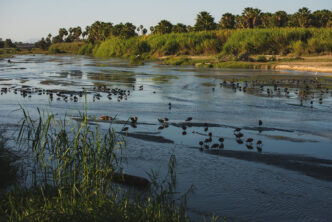As Cabo San Lucas and San José del Cabo continue expanding rapidly, local authorities are working to protect the San José del Cabo Estuary amid this growth.
Efforts are underway to update the Estuary Management Plan, a technical document outlining conservation and regulation strategies for this internationally protected wetland under the Ramsar Convention.
Jesús Alvarado, Los Cabos Town Council member and president of the Urban Development, Planning, Ecology, and Environment Commission, stated that the plan is based on scientific studies to mitigate urban growth’s impact. The updated plan, the first in over 20 years, is expected to be presented to local decision-makers within two months.
“We have been collecting scientific data for six years,” said Alvarado. “This updated plan is based on technical and scientific studies to prevent negative impacts from the municipality’s demographic growth.” He emphasized that conservation efforts would remain non-political, relying solely on scientific analysis.
The Autonomous University of Baja California Sur (UABCS) and the Estuary Advisory Council are collaborating on conservation strategies. Budget discussions are also in progress, with a focus on controlling invasive species, one of the estuary’s main ecological threats.
The San José Estuary, where the Pacific Ocean meets the Sea of Cortez, is a rare freshwater coastal oasis and one of northwestern Mexico’s most important yet threatened wetlands. Declared a State Ecological Reserve in 1994, it has suffered from increasing tourism and commercial development.
The estuary supports diverse plant life critical for bird species like the endangered Peninsular Mascarita (Geothlypis building), making it a prime destination for birdwatchers. Since 2009, 217 waterfowl species have been recorded in the area, including 97 migratory species and 19 classified as at risk. The wetland serves as a crucial resting point for birds migrating to Central and South America.
In 2023, pollution from the Fonatur Treatment Plant was reported to be severely damaging the estuary. The plant discharges 10,000 tanks of 1,100 liters of wastewater daily, leading to an overgrowth of water lilies, reeds, and tulars. However, the September 2024 rains replenished the estuary with fresh water, briefly restoring balance by reopening the bocana—the sandbar separating the lagoon from the sea.
“The removal of water lilies is simple, but invasive species like reeds and tulars require immediate action,” said Martínez. Fonatur, originally responsible for developing Los Cabos’ tourism industry, managed the treatment plant for over 30 years until President Andres Manuel Lopez Obrador dismantled the agency in 2023.
Blanca Pedrín, hotel entrepreneur and president of the Añuití Foreign Board, stated that the plant once operated efficiently, but the city’s rapid growth overwhelmed it. With a capacity of 250 liters per second, the plant now receives up to 540 liters per second at peak times, causing untreated wastewater to enter the estuary.
“As the plant struggles to handle excess wastewater, untreated discharges harm the estuary,” said Tatiana Davis, head of the State Water Commission. “The system is overwhelmed, and excess water bypasses treatment altogether.”
Political and economic interests have hindered conservation efforts. Pedrín noted that from 2011 to 2020 and again in 2022, the reserve received no management funding. In 2024, its budget was reduced to 1.2 million pesos, 800,000 pesos less than in 2023.
“Many consider the estuary dead, but we should ask ourselves: why did past generations enjoy it, and we may not?” said Francisco Colín of the Contaminants Anonymous Initiative.
One proposed solution is the Wido machine, designed to remove invasive water lilies. In 2023, funds were allocated for its purchase, but as of October 2024, the machine had not arrived, raising concerns about follow-through and accountability.
Meanwhile, Opex Latina, a Los Mochis-based company, has expressed interest in acquiring the treatment plant. Baja California Sur is exploring purchasing the treatment plant with World Bank investment to support sustainability projects without increasing public debt. Oomsapas Los Cabos, the municipal water agency, emphasizes that wastewater management legally falls under municipal jurisdiction, with private involvement requiring a concession agreement.
The San José Estuary is a vital ecological and cultural landmark, deserving of preservation for future generations.




